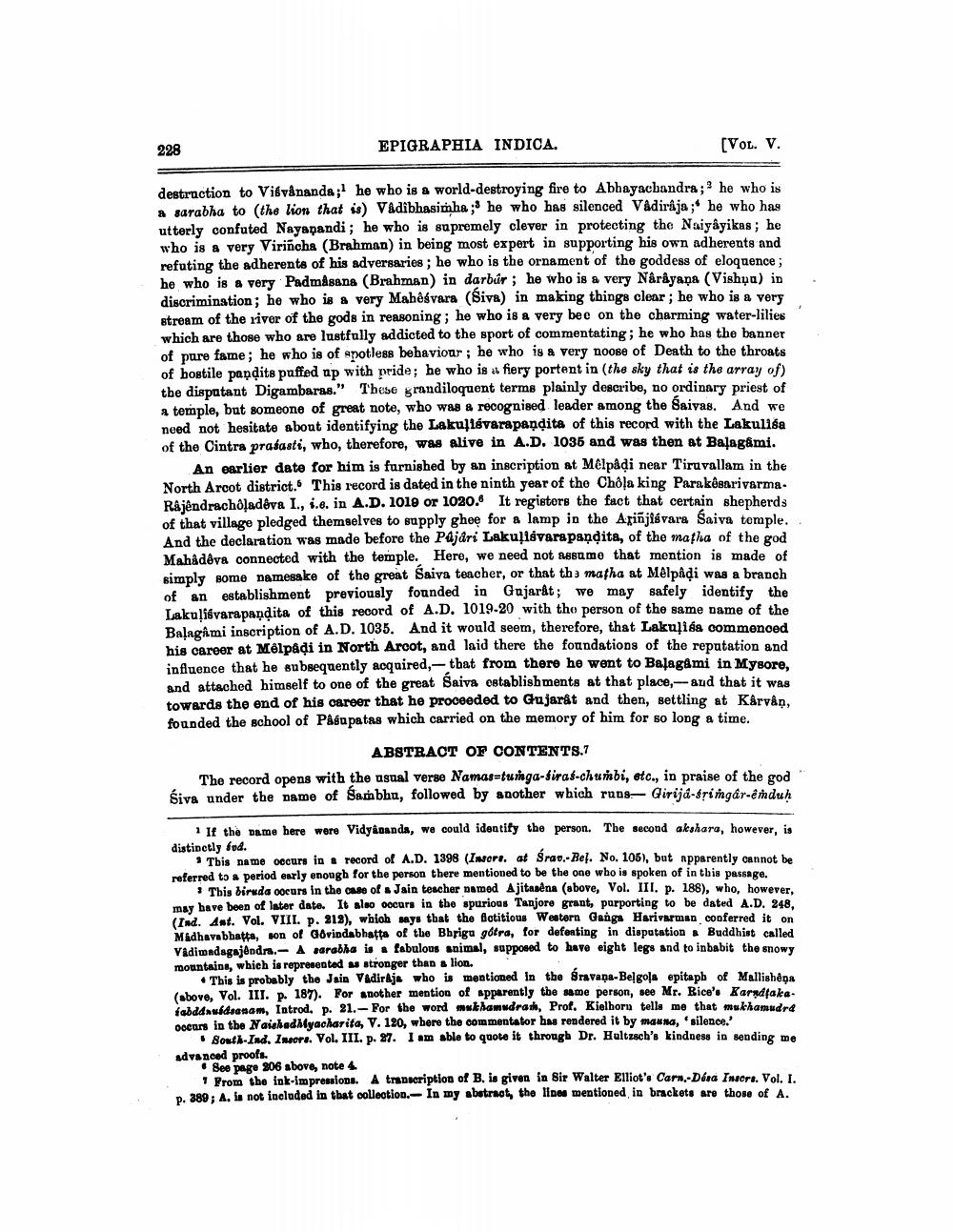________________
228
EPIGRAPHIA INDICA.
[VOL. V.
destruction to Viśvânanda; he who is a world-destroying fire to Abhayachandra; he who is a sarabha to (the lion that is) Vidibhasimha; he who has silenced Vâdirâja; he who has utterly confuted Nayapandi; he who is supremely clever in protecting the Naiyâyikas; he who is a very Virincha (Brahman) in being most expert in supporting his own adherents and refuting the adherents of his adversaries; he who is the ornament of the goddess of eloquence; he who is a very Padmasana (Brahman) in darbúr; he who is a very Nârâyana (Vishua) in discrimination; he who is a very Mahêsvara (Siva) in making things clear; he who is a very stream of the river of the gods in reasoning; he who is a very bee on the charming water-lilies which are those who are lustfully addicted to the sport of commentating; he who has the banner of pure fame; he who is of spotless behaviour; he who is a very noose of Death to the throats of hostile pandits puffed up with pride; he who is a fiery portent in (the sky that is the array of) the disputant Digambaras." These grandiloquent terms plainly describe, no ordinary priest of a temple, but someone of great note, who was a recognised leader among the Saivas. And we need not hesitate about identifying the Lakuliévarapandita of this record with the Lakulisa of the Cintra prasasti, who, therefore, was alive in A.D. 1035 and was then at Balagami.
An earlier date for him is furnished by an inscription at Mêlpâḍi near Tiruvallam in the North Arcot district. This record is dated in the ninth year of the Chôla king Parakêsarivarma. Rajendrachôladêva I., i.e. in A.D. 1019 or 1020. It registers the fact that certain shepherds of that village pledged themselves to supply ghee for a lamp in the Ariñjisvara Saiva temple. And the declaration was made before the Pajari Lakulisvarapandita, of the matha of the god Mahadeva connected with the temple. Here, we need not assume that mention is made of simply some namesake of the great Saiva teacher, or that the matha at Mêlpâḍi was a branch of an establishment previously founded in Gujarât; we may safely identify the Lakulisvarapaṇḍita of this record of A.D. 1019-20 with the person of the same name of the Balagami inscription of A.D. 1035. And it would seem, therefore, that Lakulisa commenced his career at Mêlpâḍi in North Arcot, and laid there the foundations of the reputation and influence that he subsequently acquired, that from there he went to Balagami in Mysore, and attached himself to one of the great Saiva establishments at that place,-aud that it was towards the end of his career that he proceeded to Gujarat and then, settling at Kårvån, founded the school of Pasupatas which carried on the memory of him for so long a time.
ABSTRACT OF CONTENTS.7
The record opens with the usual verse Namas-tumga-firas-chumbi, etc., in praise of the god Śiva under the name of Sambhu, followed by another which runs- Girija-sringar-êmduḥ
1 If the name here were Vidyananda, we could identify the person. The second akshara, however, is distinctly fed.
This name occurs in a record of A.D. 1398 (Insors. at śrav.-Bel. No. 105), but apparently cannot be referred to a period early enough for the person there mentioned to be the one who is spoken of in this passage.
This biruda occurs in the case of a Jain teacher named Ajitasêna (above, Vol. III. p. 188), who, however, may have been of later date. It also occurs in the spurious Tanjore grant, purporting to be dated A.D. 248, (Ind. Ant. Vol. VIII. p. 213), which says that the fictitious Western Ganga Harivarman conferred it on Madhavabhatta, son of Govindabhatta of the Bhrigu gótra, for defeating in disputation a Buddhist called Vadimadagajendra. A sarabha is a fabulous animal, supposed to have eight legs and to inbabit the snowy mountains, which is represented as stronger than a lion.
This is probably the Jain Vadiraja who is mentioned in the śravana-Belgola epitaph of Mallishêpa (above, Vol. III. p. 187). For another mention of apparently the same person, see Mr. Rice's Karnatakafabdd uideanam, Introd. p. 21.- For the word mukhamudram, Prof. Kielhorn tells me that mukhamudra occurs in the Naishadhyacharita, V. 120, where the commentator has rendered it by mauna, silence.'
South-Ind. Insors. Vol. III. p. 27. I am able to quote it through Dr. Hultzsch's kindness in sending me advanced proofs.
See page 206 above, note 4.
From the ink-impressions. A transcription of B. is given in Sir Walter Elliot's Carn.-Désa Insers. Vol. I. p. 389; A. is not included in that collection. In my abstract, the lines mentioned in brackets are those of A.




